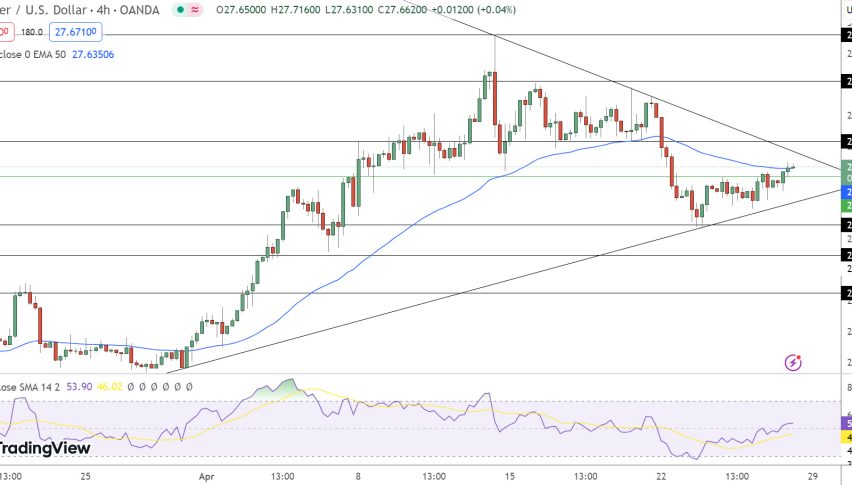Weekly Outlook, Jan 25 – 29, 2021: Top Economic Events to Watch This Week
The broad-based US dollar is going to end this week on the bearish track, as traders continue to cheer the inauguration of the Joe Biden administration by turning to riskier currencies. The new president of the United States, Joe Biden, continues to push for additional spending of up to $ 2 trillion, and this gave US shares a boost overnight and undermined the safe-haven greenback. In addition to this, the 1.9 trillion COVID-19 stimulus package proposed by Biden earlier in the month will receive the necessary Republican support in Congress, a fact that has raised hopes over economic recovery in the US from the COVID-19 pandemic.
Thus, the positive developments over the COVID-19 stimulus package and coronavirus vaccines have played a major role in weakening the safe-haven US dollar. Conversely, the losses in the greenback could be short-lived, as the recently-released US jobless data showed a decline in initial jobless claims. It is worth recalling that the sentiment-driven moves have decreased the gains in the US dollar since the Democrats won control of the US Congress earlier in the month.
Looking ahead into the coming week, the series of speeches and Unemployment Claims, along with the BoJ Monetary Policy Meeting Minutes and FOMC Statement, could drive plenty of headlines to keep the markets on the move. On a different page, the geopolitical tensions and coronavirus (COVID-19) headlines will also be closely followed, as they will play a key role in determining risk levels in the market.
Top Economic Events to Watch This Week
1) – BoJ Monetary Policy Meeting Minutes – Monday – 23:50 GMT
2) – ECB President Lagarde’s Speech – Monday – 3:45 GMT
As head of the European Central Bank, which manages short term interest rates, Lagarde has more scope for influencing the value of the Euro than any other person. Market traders closely observe her public speeches, as they usually deliver detailed clues regarding future monetary policy. Therefore, if Lagarde presents a hawkish outlook on the European economy, it is seen as bullish for the EUR, whereas a dovish outlook is considered bearish.3) – Aussie Consumer Price Index (QoQ) – Tuesday – 19:30 GMT
This data is normally released by the RBA and republished by the Australian Bureau of Statistics. It is a measure of price changes,which compares the retail prices of a representative shopping basket of goods and services. As we are all well aware, the Aussie’s purchasing power is adversely influenced by inflation. So, the CPI is seen as the key indicator that measures inflation and changes in purchasing trends. Generally speaking, an upward reading is seen as bullish for the AUD; on the flip side, a downbeat reading is seen as bearish for the Aussie currency.
Previous Release
ACTUAL: 1.6 %
DEV: 2.50
CONS: 1.5 %
DATE: 10/28/2020 00:30
4) – RBA Trimmed Mean CPI (QoQ):
This data is usually released by the RBA and republished by the Australian Bureau of Statistics. It is a study of price movements, through the comparison of the retail prices of a representative selection of goods and services. A trimmed mean is assumed as the weighted average of the central 70% of the quarterly price change distribution of all CPI components, with the annual rates based on compound quarterly calculations.
Previous Release
ACTUAL: 0.4 %
DEV: 1.02
CONS: 0.3 %
DATE: 10/28/2020 00:30
5) – Fed Interest Rate Decision – Wednesday – 14:00 GMT
Like other Central Banks, the US Central Bank has regular economic policy meetings, during which board members implement different measures, the most relevant one being the interest rate that will be charged on loans and advances to commercial banks. The Board of Governors of the Federal Reserve meets at intervals of 5 to 8 weeks, after which they announce their latest decisions regarding interest rates. Rate hikes are considered a sign of healthy inflation, so they tend to boost the local currency, the US dollar. Conversely, rate cuts are considered a sign of economic and inflationary woes, which, in turn weaken the greenback. If rates do not change, the attention turns to the tone of the FOMC statement.
Previous Release
ACTUAL: 0.25 %
DEV: 0.00
CONS: 0.25 %
DATE: 12/16/2020 19:00
ii) Fed’s Monetary Policy Statement:
Directly after the Fed’s rate decision, the FOMC publishes its statement about monetary policy. The statement typically affects the volatility of the USD and determines a short-term positive or negative trend. Generally speaking, a hawkish outlook is seen as bullish for the US dollar, and a dovish view is understood as negative or bearish.
Previous Release
DEV: 0.57
CONS: 50 K
DATE: 12/17/2020 00:30
6) – Advance GDP q/q – Thursday – 8:30 GMT
This data is normally released by the US Bureau of Economic Analysis, which measures the monetary value of all the goods, services and structures produced within the country in a pre-determined period. The Annualized GDP is a gross measure of market activity, because it helps to gauge the speed at which a country’s economy is growing or shrinking. Generally speaking, an uptrend is understood as bullish for the USD currency; alternatively, a lower reading is seen as negative or bearish for the US currency.
ACTUAL: 33.4 %
DEV: 0.39
CONS: 33.1 %
DATE: 12/22/2020 13:30ii) – Unemployment Rate:This data is normally released by the US Department of Labor Statistics, which measures the number of unemployed workers divided by the total civilian labor force. Rate hikes indicate a lack of expansion within the US labor market, which tends to weaken the US economy. Low readings are therefore seen as positive or bullish for the US currency; conversely, high figures are seen as negative (or bearish) the USD.
Previous Release
ACTUAL: 900 K
DEV: -0.11
CONS: 910 K
7) – Gross Domestic Product (MoM) – Friday – 8:30 GMT
Statistics Canada releases this data, which is a measure of the total value of all goods and services produced in Canada. The GDP is understood as a gross measure of Canadian economic activity and health. In simple words, a high figure has a bullish effect on the CAD, whereas low figures are considered negative for the Canadian currency.
Previous Release
ACTUAL: 0.4 %
DEV: —
CONS: —
DATE: 12/23/2020 13:30












